
The luna moth, also called the American moon moth, is a Nearctic moth in the family Saturniidae, subfamily Saturniinae, a group commonly named the giant silk moths.

Macaria signaria, the dusky peacock, pale-marked angle or spruce-fir looper, is a moth of the family Geometridae. The species was first described by Jacob Hübner in 1809. Subspecies Semiothisa signaria signaria is found in Europe, Turkey, the Caucasus, Transcaucasia, the Ural, Siberia, Far East, Sakhalin, northern Iran and Japan. Subspecies Macaria signaria dispuncta is found in North America.
Macaria bicolorata, the bicolored angle, is a moth of the family Geometridae. It is found in Eastern North America.

Macaria fissinotata, the hemlock angle, is a moth of the family Geometridae. It is found in North America from Nova Scotia to Georgia, west to Kentucky, north to Ontario.

Macaria is a genus of moths in the family Geometridae erected by John Curtis in 1826. It is sometimes placed as a synonym of Semiothisa. Species are cosmopolitan.

Ancylis comptana, the strawberry leaf-roller or Comptan's ancylis moth, is a moth of the family Tortricidae. It is found from the United Kingdom and Scandinavia to northern Spain and Turkey, Asia Minor, Kazakhstan, Uzbekistan, Russia, China, Mongolia, Korea and Japan. In North America, it is represented by ssp. fragariae.
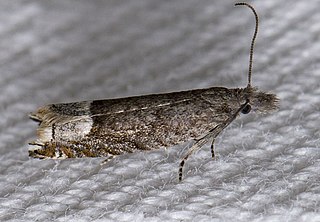
Ancylis tineana is a moth of the family Tortricidae. It is found from southern Sweden to Asia Minor and from the Trans-Caucasus to Siberia and the southern part of eastern Russia. It is also present in North America.

Gypsonoma minutana, the poplar tortricid, is a moth of the family Tortricidae. It is found in Europe and North Africa, Turkey, Transcaucasia, Ural, Kazakhstan, from central Asia to Siberia and eastern Russia, Asia Minor, Iran, Afghanistan, Mongolia, China and Japan.
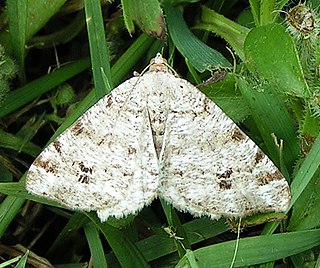
Macaria pinistrobata, the white pine angle, is a moth of the family Geometridae. It is found in the Eastern United States as well as the Canadian provinces of Ontario, Quebec, New Brunswick, Prince Edward Island, and Nova Scotia.
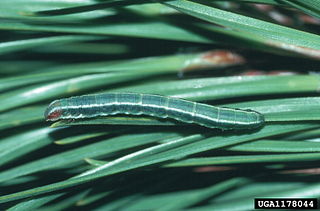
Macaria granitata, the granite moth, is a moth of the family Geometridae. It is found in Pennsylvania, Maine, New Hampshire, New England, New Jersey, southern Quebec, Ohio, North Carolina, South Carolina and Georgia.
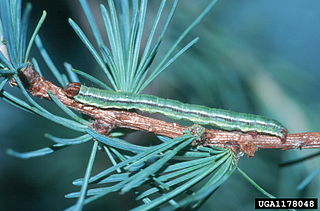
Macaria oweni, Owen's larch looper or Owen's angle moth, is a moth of the family Geometridae. The species was first described by Louis W. Swett in 1907. It is found in North America from Newfoundland to west-central Alberta, south in the east to northern New England.
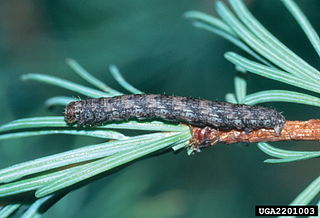
Macaria sexmaculata, known by the common names green larch looper, larch looper or six-spotted angle, is a moth of the family Geometridae. It is found from Alaska to Nunavut and Newfoundland, south in the east to Massachusetts and south in the west to Oregon.
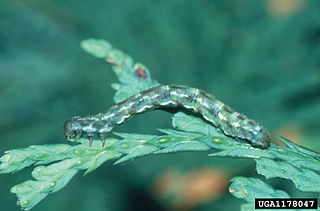
Macaria multilineata, the many-lined angle, is a moth of the family Geometridae. It is found from New England, New York and Ontario to Florida, west to Oklahoma and Iowa.

Macaria loricaria, the false Bruce spanworm or Eversmann's peacock, is a moth of the family Geometridae. It is found from Fennoscandia and the Baltic states to Sakhalin. It is also found in North America, where it is found from Alaska to Newfoundland and New York, south to Colorado.

Scopula incanata is a species of moth in the family Geometridae. It is found from north-eastern Europe and the Caucasus to southern Siberia and northern Mongolia.

Macaria aemulataria, the common angle moth, is a moth in the family Geometridae. The species was first described by Francis Walker in 1861. It is found from Nova Scotia to Florida, west to Texas, north to Oregon and Alberta.

Lycaena helloides, the purplish copper, is a butterfly of the family Lycaenidae. It is found in North America from the Great Lakes area to British Columbia, south to Baja California.
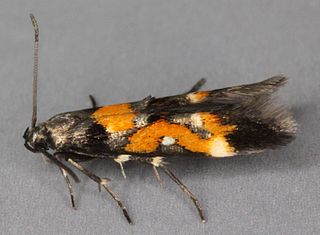
Mompha locupletella is a moth in the family Momphidae that can be found in the Palearctic including Europe.

Macaria aequiferaria, the woody angle moth, is a moth of the family Geometridae. The species was first described by Francis Walker in 1861. It is found in North America, where it has been recorded from Maryland, and Delaware to Florida, west to Texas, as well as in Oklahoma, Mississippi, Kentucky and southern Illinois. It is also found in Mexico.

Macaria minorata, the minor angle moth, is a moth of the family Geometridae. The species was first described by Alpheus Spring Packard in 1873. It is found in North America, where it has been recorded from Nova Scotia to Ontario, Quebec, Minnesota, New England, Maryland, North Carolina, South Carolina and Georgia.



















